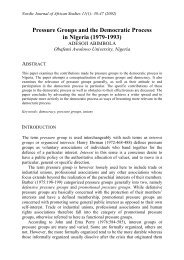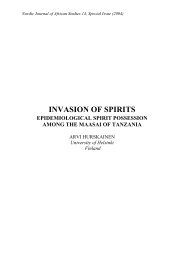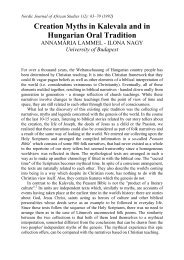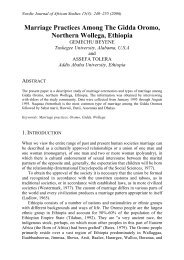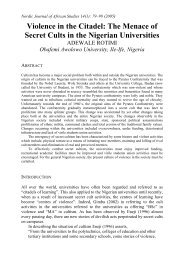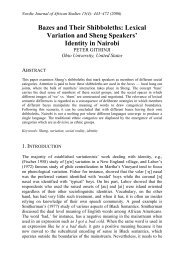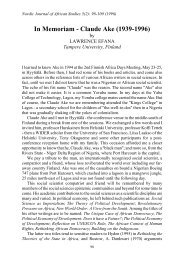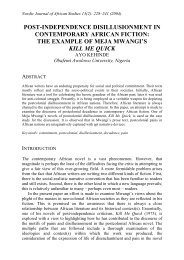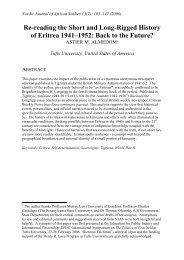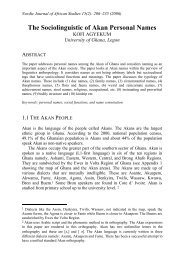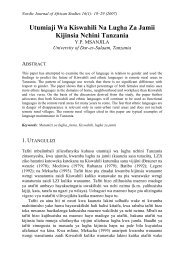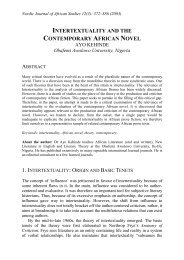Hottentot, Bushman, Kaffir: Taxonomic Tendencies in Nineteenth
Hottentot, Bushman, Kaffir: Taxonomic Tendencies in Nineteenth
Hottentot, Bushman, Kaffir: Taxonomic Tendencies in Nineteenth
You also want an ePaper? Increase the reach of your titles
YUMPU automatically turns print PDFs into web optimized ePapers that Google loves.
Nordic Journal of African Studies<br />
state that, sett<strong>in</strong>g aside that stage of the enterta<strong>in</strong>ment when he counterfeited the<br />
death of some creature he had shot, by lay<strong>in</strong>g his head on his hand and shak<strong>in</strong>g<br />
his left leg - at which time I th<strong>in</strong>k it would have been justifiable homicide to slay<br />
him - I have never seen that group sleep<strong>in</strong>g, smok<strong>in</strong>g, and expectorat<strong>in</strong>g round<br />
their brazier, but I have s<strong>in</strong>cerely desired that someth<strong>in</strong>g might happen to the<br />
charcoal smoulder<strong>in</strong>g there<strong>in</strong>, which would cause the immediate suffocation of<br />
the whole of the noble strangers (Dickens 1853: 337-38).<br />
Dickens was debunk<strong>in</strong>g the Romantic myth of the Noble Savage but he wasn't<br />
entirely jok<strong>in</strong>g. Believ<strong>in</strong>g as he did that the Noble Savage's "virtues are a fable; his<br />
happ<strong>in</strong>ess is a delusion; his nobility, nonsense" and that "the world will be all the<br />
better when his place knows him no more," Dickens recommended more than<br />
half-seriously that it would be "someth<strong>in</strong>g highly desirable" for all such people to<br />
be "civilized off the face of the earth" (Dickens 1853: 339). If this wasn't a cry for<br />
literal genocide, it must at least be recognized as a call for cultural genocide, which<br />
perhaps amounts to the same th<strong>in</strong>g.<br />
Dickens wasn't their only detractor. Pictorial representations of the Bosjesmans<br />
<strong>in</strong> the media of the day were not at all flatter<strong>in</strong>g, the consensus among observers<br />
be<strong>in</strong>g that these were exceed<strong>in</strong>gly ugly creatures who differed as much from<br />
Europeans <strong>in</strong> appearance as <strong>in</strong> <strong>in</strong>telligence. To heighten the contrast between<br />
savage and civilized, some illustrated papers such as the Pictorial Times and<br />
Sportsman's Magaz<strong>in</strong>e pr<strong>in</strong>ted sketches of the Bosjesmans danc<strong>in</strong>g wildly while<br />
their fashionably dressed exhibitor stood sedately <strong>in</strong> the background look<strong>in</strong>g on<br />
(Fig. 4). 14 For the show itself a large poster was prepared, illustrated with scenes<br />
said to be typical of Bosjesman life: "Quarrels of <strong>Bushman</strong>," "Fight of <strong>Bushman</strong>,"<br />
"Trac<strong>in</strong>g the Footsteps of the Enemy," "Kill<strong>in</strong>g the Puff Adder," "Prepar<strong>in</strong>g for<br />
Dance," etc. Significantly, the borders between the vignettes were lurid with snakes<br />
and animal heads. 15 Less sensational images of the women and child <strong>in</strong> the troupe<br />
were used <strong>in</strong> the fourth edition of a lead<strong>in</strong>g ethnological textbook, James Cowles<br />
Prichard's The Natural History of Man (1855), but even these "scientific" plates did<br />
not make them look attractive (Prichard 1855: plates xvii and xviii). David<br />
Liv<strong>in</strong>gstone may have been right when he said of the Bosjesmans that "the<br />
specimens brought to Europe have been selected, like costermonger's dogs, on<br />
account of their extreme ugl<strong>in</strong>ess." But one wonders if he was justified <strong>in</strong> mak<strong>in</strong>g a<br />
still more demean<strong>in</strong>g comparison: "That they are, to some extent, like baboons is<br />
14 Pictorial Times, June 12th 1847, p. 376; Sportsman's Magaz<strong>in</strong>e, July 10th 1847, p. 319.<br />
Although the sketch is the same <strong>in</strong> both papers, the Pictorial Times identifies the figure <strong>in</strong> the<br />
background as Dr. Robert Knox, while Sportsman's Magaz<strong>in</strong>e says he is Mr. J.S. Tyler. Knox,<br />
an Ed<strong>in</strong>burgh anatomist who had been <strong>in</strong>volved <strong>in</strong> the notorious Burke and Hare scandal, gave an<br />
anthropological lecture as part of the show; Tyler was the manager who accompanied the<br />
Bosjesmans on their tour. The Illustrated London News, June 12th 1847, p. 381, pr<strong>in</strong>ted a<br />
similar sketch of the group and identified the gentleman sitt<strong>in</strong>g <strong>in</strong> the background as Tyler.<br />
15 This poster is preserved <strong>in</strong> the John Johnson Collection, Bodleian Library, Oxford University.<br />
12



